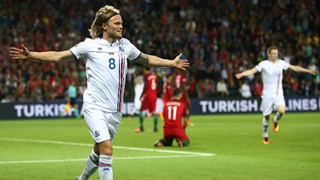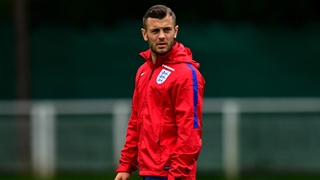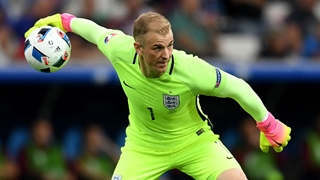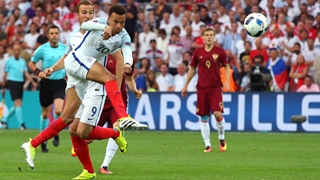
Iceland got their first ever European Championship campaign off to a memorable start with a 1-1 draw against Portugal on Tuesday evening.
FA Education Content Editor Peter Glynn looks at how the smallest country ever to qualify for the tournament frustrated Ronaldo and company with a determined and dogged performance and outlines five discussion points for coaches.
Portugal 1-1 Iceland
UEFA Euro 2016
Group F
Tuesday 14 June 2016
Stade Geoffrey Guichard, Saint-Etienne
Live on BBC One
1. Pressing with intent
After a first half played out almost solely in their own territory, Iceland adopted a much more aggressive pressing strategy in the second period with the aim of disrupting Portugal’s domination of possession.
For 45 minutes, the Icelanders - who adopted a 4-4-2 shape throughout – were content to sit deep in their own half to deny space behind their backline, in turn reducing the threat posed by Ronaldo and Nani’s forward running.
Remaining compact as a defensive unit, Iceland shuffled and slid across the pitch retaining the distances between individuals and units.
However, after the restart, much greater pressure was applied to the man in possession with the Icelanders not only quickly closing opponents down but more willing to tackle and physically challenge for the ball.
The greater engagement in 1v1 duels succeeded in unsettling Portugal who couldn’t find the passing rhythm they enjoyed in the first period.
2. Anticipation and second-balls
Iceland’s attacking strategy was based around regaining possession and directing accurate long passes for their twin strike force of Jon Dadi Bodvarsson and Kolbeinn Sigthorsson – both of who possessed an aerial threat.
With possession often put at risk through this approach, there was a responsibility on Iceland’s midfield to quickly provide support for any knock-downs and second-balls.
Swansea midfielder Gylfi Sigurdsson, in particular, displayed impressive physical qualities to repeatedly make forward runs to support his front men. In addition, Iceland’s talisman showed the importance of anticipating, sensing and predicting where the ball might drop.
Iceland’s dual strike force and direct threat provided a reminder that no one style of play is exclusive to international football and teams must be prepared to combat a variety of approaches.
3. Portugal’s rotation and interchange
For all the euphoria surrounding their performance, it shouldn’t be forgotten that Iceland were reduced to the role of spectators in the first period.
This had much to do with Portugal’s fluid rotation and interchange of positions in midfield and attack.
Only Portugal’s defensive screen, Danilo, was tasked with holding his position at the base of the midfield, with the five forward players ahead of him given licence to swap positions whilst Portugal were in possession.
Although the end product often didn’t match the proceeding movement, the way in which the Portuguese effortlessly recognised and responded to the movement of their team-mates in order to create passing lines – particularly in the first period – was impressive.
With Valencia’s Andre Gomes, equally adept at operating in pockets of space on both flanks, in central areas as well running from deep, there were further examples of the characteristics and attributes needed to operate as a modern attacking midfielder within this approach.
4. Full-backs as wingers
As has been already been common in this tournament, Portugal’s width was provided by their full-backs Vieirinha and Raphael.
With wide attackers Gomes and Joao Mario continually drifting inside to adopt those difficult to define positions between midfield and attack, space was created in wide areas for their full-backs to exploit.
This strategy proved to underline the necessity for attacking full-backs to possess as many attacking qualities as they do defensive ones.
5. Game management: staying in the game
Although large parts of this game saw Portugal have exclusive control of the ball, Iceland’s dogged determination and unified approach saw them stay in the game long enough to begin to build momentum and believe they could take something from the contest.
Many may question Iceland’s seeming willingness to give the ball back to their opponents – as Ronaldo did after the game - however the longer the game went without Portugal adding to Nani’s 31st minute opener the greater the belief that could be seen running through Lars Lagerback’s side.
With many more tight contests to come having different strategies in order to stay in a game may be critical.
Peter Glynn is FA Education Content Editor and will be providing comment and analysis throughout Euro 2016.
Peter is editor of The FA’s coaching magazine, The Boot Room, and is a holder of the FA Advanced Youth Award and UEFA B coaching licence.
Follow Peter on twitter: @_peterglynn
*The views expressed in this article are those of the author and not necessarily The Football Association
















